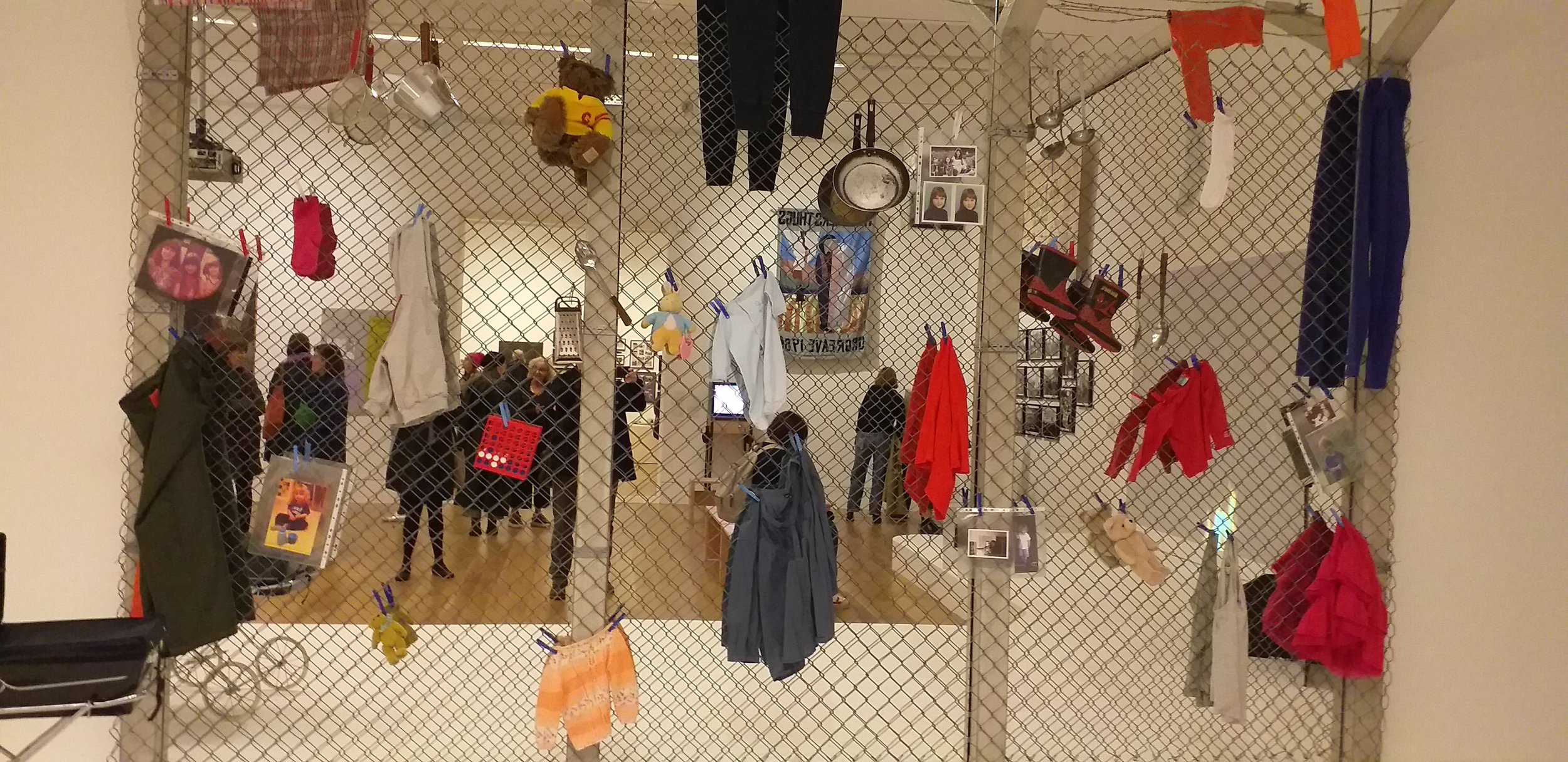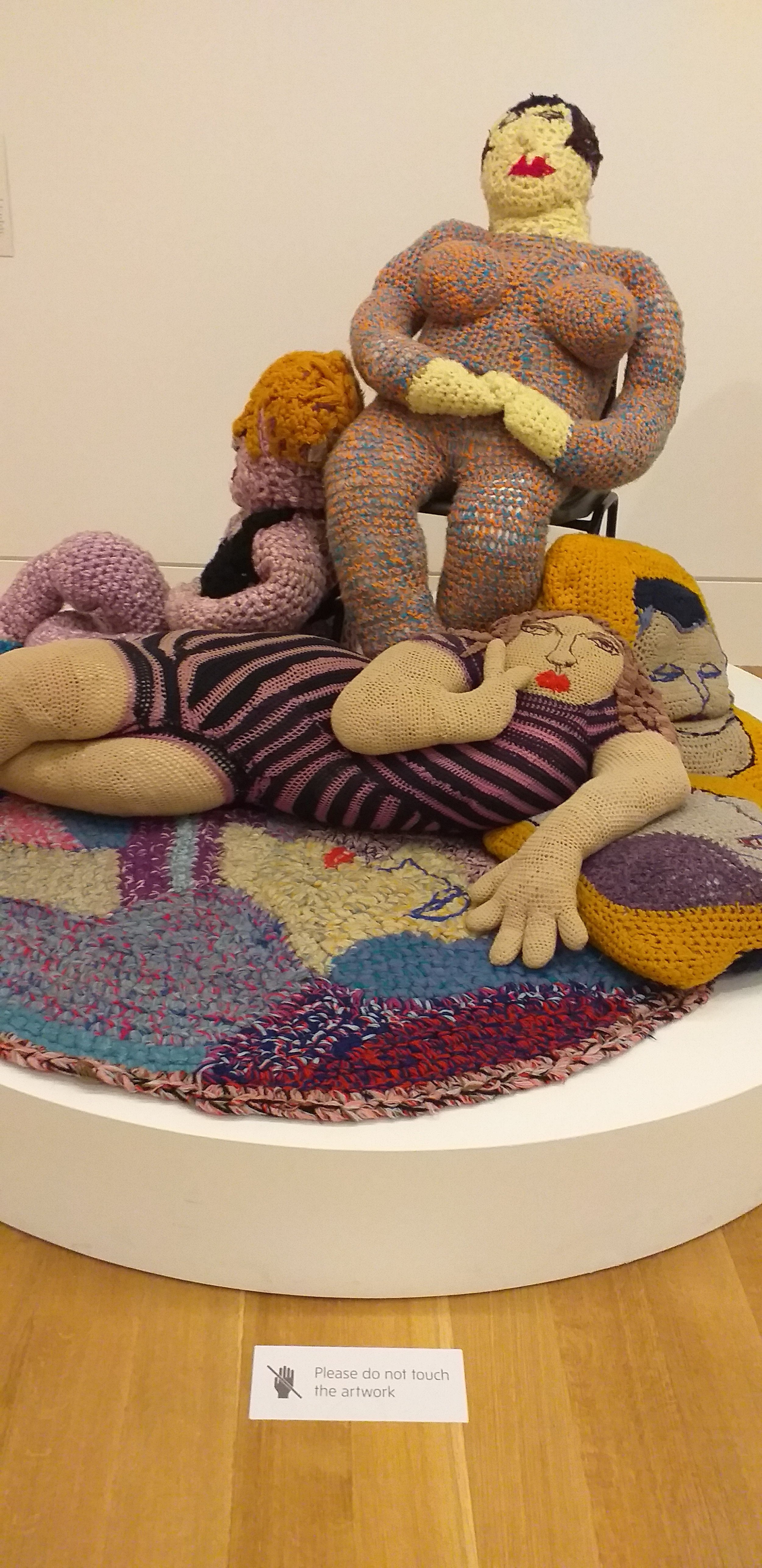WOMEN IN REVOLT!
Recreated section of the Greenham Common fence.
It can be rather disconcerting to find that events and objects familiar as part of your own life are becoming categorised as “historical”. It feels a little personal, as if one is being mothballed. Similarly, the term is often used by academics or institutions to suggest that social and political movements – by their very nature living and organic – have been reduced to dead things, objects that are ready to be carefully packaged and stored away in a museum basement.
Walking into Tate Britain's major exhibition of art from the Women's Liberation Movement in Britain, Women in Revolt!, I was immediately struck by the way that the retrospective character of the show suggested just such a packaging. As the opening sentence of the exhibition's accompanying text points out, “In the early 1970s, women were second-class citizens”. Were. The struggle is over; no need for all this feminist fuss anymore. That would seem to be the implication.
I don't think for a moment that is the conscious intent of the organisers and curators. But to an extent, perhaps such a historicization is inevitable within the gallery setting. The art of curation involves forming a narrative, selecting which elements to include or more crucially exclude in order to tell a chosen story. In the case of Women in Revolt!, a curatorial decision to frame the art of the British women's movement within the period from 1970 to 1990 necessarily boxes things in. It also means the exhibition leaves out of the frame many women artists who might be considered precursors as well as those who have continued to make distinctly political art in the years since.
Life-size crochet figures by Rita McGurn.
Another aspect that's quite obvious is a heavy emphasis on art that could be categorised as “agitprop”. Again, perhaps unavoidable given that this is, after all, art that has emerged from an agitational movement. The tone is somewhat set by a quote from Monica Sjöö, displayed at the exhibition entrance, that apparently damns abstraction as an inherently patriarchal approach to artmaking. This might have triggered my personal defensiveness (as an artist who works with abstraction), but in any case it seems unfairly dismissive of the many women artists who have worked with, and continue to work with, abstraction. Helen Frankenthaler, for instance, might also have disagreed with Sjöö's remark, which comes across as declaration of a kind of feminist Proletkult in which only the approved artforms are permitted.
Art as agitprop contains and generates its own drives and contradictions. The sheer immediacy of its impact is a strength. And Women in Revolt! certainly reflects that immediacy, the artworks almost a catalogue of feminist campaigns through two decades of struggle. From the posters for Britain's first National Women's Liberation Conference in 1970, through pro-choice campaigning, Wages For Housework, Reclaim the Streets, the growth of Black women's organisation, the emergence of the gay and lesbian liberation movement, Greenham Common, the Miners' Strike, punk rock and Rock Against Racism, what comes across very clearly is the sheer vitality of a genuine social movement.
On the other hand, where it was created as primarily agitational material, the art can lose much of its original power, as time and campaigning move on and the original context is left behind. It's difficult to quantify this, but there is a sense of alienation when magazines intended to communicate and, above all, organise are sealed inside a vitrine, or a banner meant to send a message of both solidarity and protest on the streets is suspended on a gallery wall.
There's another element missing from this exhibition, and it seems to me – assuming that it isn't a deliberate exclusion – that it's a significant oversight. Neo-paganism, and especially various branches of Goddess-centred spirituality, grew into a major influence on the Women's Liberation Movement of the period. Monica Sjöö, prominently featured with several paintings as well as the aforementioned text included in the show, was of course author of a seminal book in the development of Goddess spirituality, The Great Cosmic Mother. I remember that Starhawk's The Spiral Dance was almost regarded as compulsory reading by many feminist women in the 1980s; and Starhawk herself delivered workshops at the peace camp outside the military base at Greenham Common.
Some recognition of this influence does sneak in. The Neo Naturist collective, whose work focuses on ecology and spirituality within a feminist perspective, are represented with paintings by Jennifer Binnie and Wilma Johnson alongside photographs of their subversive and provocative performance work. A section of the Greenham Common fence is reproduced, hung with everyday items such as clothing, a teddy bear and a frying pan in an act of magical sabotage by the women of the peace camp. This is, though, understating the central role that acts of ritual and other magic began to play within feminist campaigning throughout the 1980s.
While recognising such limitations, Women in Revolt! is still a powerful and important exhibition. It's striking that so much of the art on display is the product of collective activity; and that there is such a diversity of approaches, from painting and sculpture to performance art. Objects exhibited from the Postal Art Event (1975-77), for instance, capture the activity of a nationwide network of women who extended the concept of mail art in order to question the whole notion of “fine art”.
Feminist artists took up the slogan of “the personal is political” to question patriarchal assumptions about women's lives and women's roles in society. Jo Spence brilliantly subverts the conventions of the family photographic album and the scrapbook. Spence wrote, “In my early photographs there is no record of my appalling health...no record of the pointless years shunted around schools...no record of a broken marriage...no record of hard work done for countless employers, no record of trying to please parents and other authority figures”. Here, in Beyond the Family Album, such matters push aside the images of personal harmony to take the centre stage.
Performance art, particularly, took on a central role in the creativity of the women's art movement. The female body, seen as a terrain of political struggle, became a focus for artists such as Catherine Elwes and Rose English; and performance art, by its very nature as an embodied work, can forefront questions of the body and body image, sexuality, and so on. It isn't really possible to capture the intensity of performance through two-dimensional documentation in photographs. Some of the original energy of English's work does communicate strongly, though, through several of the Porcelain Dancers that she originally made in order to destroy them at the climax of a performance.
There is always a danger that the energies of activism can, over time, decline into nostalgia. Indeed, there were plenty of older women – possibly veterans of the activism that originally gave rise to the art – touring the gallery and sharing memories of the period. “I remember that poster”, was a comment that could be overheard frequently. I'll admit that I muttered similar comments, quite a few times, while touring the show.
However, simple nostalgia would be to miss the point. As my own partner remarked, reading accounts from working-class women of their crowded daily routines balancing paid (often menial) jobs with housework and childcare, “This hasn't really changed”. That's the blunt reality for the overwhelming majority of women. And that remains the continuing point of relevance for the art of women's liberation.
Women in Revolt! continues at Tate Britain, in London, until 7th April 2024.
Philip Kane
By Grace Sanchez
Philip Kane is an award-winning poet, author, storyteller and artist, living in the south-eastern corner of England. He is an “Old Craft” practitioner, a supporter of Anti-Capitalist Resistance, and a founding member of the London Surrealist Group. Philip's work has been published and exhibited across Europe, in the Middle East and in the USA. He is a contributor to The Gorgon's Guide to Magical Resistance (Revelore Press, 2022).



